
Baptisia is a genus in the legume family, Fabaceae. They are flowering herbaceous perennial plants with pea-like flowers, followed by pods, which are sometimes inflated. They are native to woodland and grassland in eastern and southern North America. The species most commonly found in cultivation is B. australis.
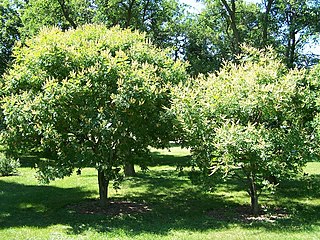
Maackia is a genus of flowering plants in the legume family, Fabaceae. There are about 12 species, all native to eastern Asia, with six endemic to China. The generic name honors the botanist Richard Maack.

Behaimia is a genus of legume in the family Fabaceae. It is only found in Cuba. It can be distinguished from related genera, Cyclolobium and Limadendron by:
pinnately multifoliolate leaves, a sessile ovary, and an indehiscent or late dehiscent one-seeded pod.
Dicraeopetalum is a genus of flowering plants in the family Fabaceae.
Neoharmsia is a genus of legume in the family Fabaceae.

Pericopsis is a genus of legume in the family Fabaceae.
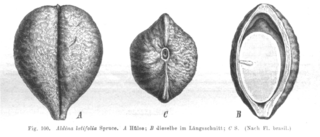
Aldina is a genus of trees in the Fabaceae native to the Guiana Shield and northern Amazonia. It is found in lowland humid forests.

Psorothamnus is a genus of plants in the legume family. These are shrubs and small trees. Many are known by the general common name indigo bush. Some are referred to as daleas, as this genus was once included in genus Dalea. These are generally thorny, thickly branched, strongly scented bushes. Most species bear lupinlike raceme inflorescences of bright purple legume flowers and gland-rich pods. Psorothamnus species are native to the southwestern United States and northern Mexico. The genus is paraphyletic and it has been proposed that the genus Psorodendron be reinstated to accommodate sections Xylodalea, Capnodendron, and Winnemucca.

Barklya is a genus of Australian trees in the legume family, Fabaceae. It belongs to the subfamily Cercidoideae. The sole species is Barklya syringifolia, commonly known as golden crown or golden glory. It grows in rainforest to 20 metres tall. Recorded from Queensland and New South Wales in rain forest. It is often used as an ornamental.
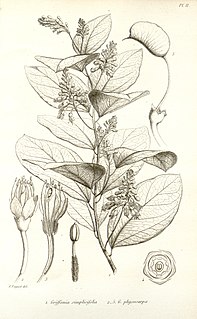
Griffonia is a genus of flowering plants in the legume family, Fabaceae. It belongs to the subfamily Cercidoideae. Griffonia is known to have a high concentration of 5-HTP in its seeds.
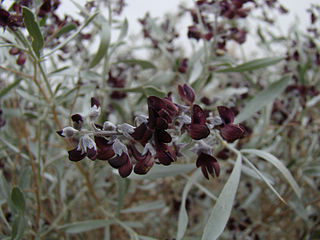
Ammodendron is a genus of flowering plants, called the sand acacias, in the family Fabaceae. It belongs to the subfamily Faboideae. Its name is derived from the Greek άμμοςammos ("sand") and δένδρονdendron ("tree").

Apoplanesia is a genus of flowering plants in the family Fabaceae. It belongs to the subfamily Faboideae.

Bolusanthus speciosus is a species of flowering plants in the family Fabaceae. It belongs to the subfamily Faboideae. It is the only member of the genus Bolusanthus.

Calicotome is a genus of flowering plants in the family Fabaceae. It belongs to the subfamily Faboideae. It may be synonymous with Cytisus. All species of the genus are thorny shrubs. The ancient Greeks believed that tyrants in Hades were punished by being beaten with the thorny calycotomes.

Cytisophyllum sessilifolium is a species of flowering plants in the family, Fabaceae. It belongs to the subfamily Faboideae. It is the only member of the genus Cytisophyllum.
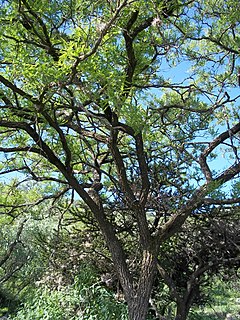
Eysenhardtia is a genus of flowering plants in the family Fabaceae. It belongs to the subfamily Faboideae. Members of the genus are commonly known as kidneywoods.
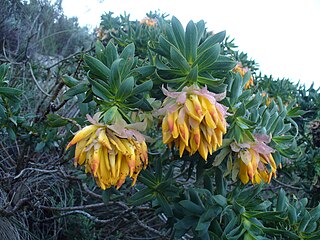
Liparia is a genus of flowering plants in the legume family, Fabaceae. It belongs to the subfamily Faboideae.

Cytisus nigricans, the black broom, is a species of flowering plant in the subfamily Faboideae of the family Fabaceae. Growing 3–5 ft (0.91–1.52 m) tall, it is a slender deciduous shrub with erect branches. Masses of brilliant yellow, slightly fragrant pea-like flowers appear in long racemes on the current year's growth in summer and early autumn.
Lasiobema is a genus of flowering plants in the legume family, Fabaceae, most of which are lianas. It belongs to the subfamily Cercidoideae. It was recently synonymized with Phanera on the basis of morphology, but this move has been questioned.
Ammothamnus is a genus of flowering plants in the family Fabaceae. It belongs to the subfamily Faboideae. It is sometimes included in the genus Sophora.



















